Bond LSC News
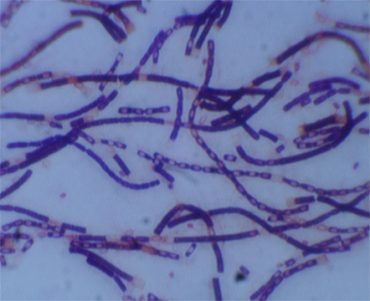
Feb. 7, 2014
Quicker anthrax detection could save millions of dollars, speed bioterror response
Anthrax bacteria is a rod-shaped culture. Most common forms of transmission are through abrasions in the skin and inhalation. Imagine researchers in hazmat suits moving slowly and deliberately through a lab. One of them holds up a beaker. It’s glowing. This light — or the absence of it — could save millions of dollars for governments and save the lives of anthrax victims. Scientists at the University of Missouri Laboratory of Infectious Disease Research proved a new method for anthrax detection can identify anthrax quicker than any existing approach. When the “bioluminescent reporter phage” —…
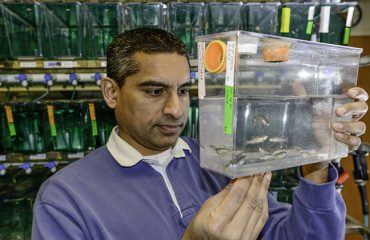
Feb. 3, 2014
Mind map: Bond LSC research explains how proteins guide migrating neurons
Bond LSC scientist Anand Chandrasekhar studies the zebrafish model to learn how motor neurons develop. These adult zebrafish lay eggs used to gain insight into how motor neurons arrange themselves as embryos grow into adults. Roger Meissen/ Bond LSC Three thousand zebrafish swim circles in tanks located on the ground floor of the Bond Life Sciences Center, content to mindlessly while away their existence by eating their fill and laying eggs. Despite their very basic higher functions, Bond LSC researcher Anand Chandrasekhar wants to understand how their brains work. More importantly, he wants to know how individual…
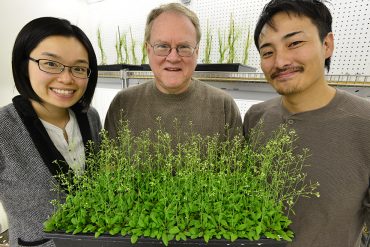
Jan. 16, 2014
Bond LSC team identifies first plant receptor for extracellular ATP
Jeongmin Choi (left), Gary Stacey (center) and Kiwamu Tanaka recently discovered the first plant receptor for extracellular ATP using Arabidopsis plants. Roger Meissen/Bond LSC It’s the genetic equivalent to discovering a new sensory organ in plants. A team at the University of Missouri Bond Life Sciences Center found a key gene that sniffs out extracellular ATP. Scientists believe this is a vital way plants respond to dangers, such as insects chewing on its leaves. The journal Science published their research Jan. 17. “Plants don’t have ears to hear, fingers to feel or eyes to see. They recognize…
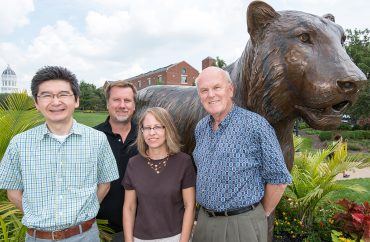
Jan. 13, 2014
Bond LSC researchers search for causes of complex pregnancy disorder
Toshihiko Ezashi (left), Danny Schust (middle), Laura Schulz (middle) and Michael Roberts (right) collaborate on new research to discover the causes of preeclampsia. Roger Meissen/ Bond LSC You can’t see the resemblance, but cells in Michael Roberts’ lab share a family tree with some newborns. Their common genetics may help explain severe, early-onset preeclampsia, an inherited disorder that leads to a placenta that is often small and inefficient and possibly due to the mother’s body not fully welcoming her pregnancy. University of Missouri Health Center scientists such as Danny Schust and Laura Schulz, work with Roberts and…
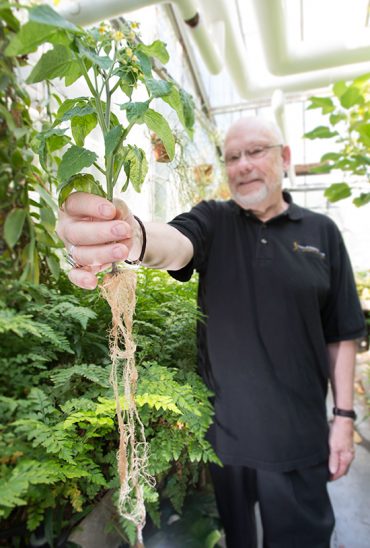
Nov. 22, 2013
The sweet path: how scientists try to understand sugar movement in plants
Roots play a key role in regulating where sugar ends up in plants like tomato. Plant scientists are borrowing a tool from medicine to unravel how plants fight off an attack. The Schultz-Appel Chemical Ecology lab used PET scans to decipher how and when a plant uses resources to fight off a disease or insect. Positron emission tomography (PET) scans detect radioactive tracers and how they travel over time. In humans the scan tracks blood flow to find cancers, understand brain activity and show uptake…
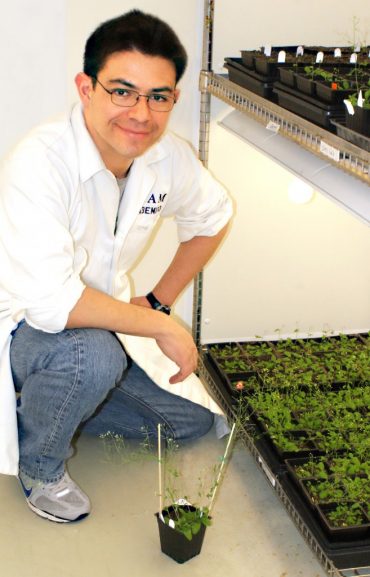
Nov. 8, 2013
Searching for the gene: MU scientist works to find link to nutrient content of seeds
David Mendoza-Cozatl uses Arabidopsis plants like these as a model to understand how plants transport nutrients from soil to seeds and leaves.Courtesy Randy Mertens/CAFNR Forget fruits and vegetables, seeds provide a critical part of the average person’s diet. From beans to cereal grains, understanding how genes and soil types impact nutrition could one day help produce more nutritious food. One University of Missouri researcher wants to know which genes control the elements in these nutrient-rich packages. “Iron and zinc deficiencies are considered two major nutritional disorders in the world,…
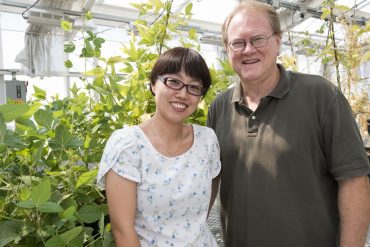
Sep. 9, 2013
The secret of the legume: Bond Life Sciences Center researchers pinpoint how some plants fix nitrogen while others do not
Yan Liang and Gary Stacey research the symbiosis between legumes, like these soybeans, and nitrogen-fixing bacteria at the Bond Life Sciences Center. A silent partnership exists deep in the roots of legumes. In small, bump-like nodules on roots in crops like soybeans and alfalfa, rhizobia bacteria thrive, receiving food from these plants and, in turn, producing the nitrogen that most plants need to grow green and healthy. Scientists have wondered for years exactly how this mutually beneficial relationship works. Understanding it could be the first step toward engineering other crops to use less nitrogen, benefitting both…

Aug. 16, 2013
MU researchers tackle tough grapevine pest
Division of Plant Sciences and Bond LSC investigators Jack Schultz and Heidi Appel have been awarded a grant by the National Science Foundation to unravel the mystery of how an insect pest gets the better of the world’s – and Missouri’s – most valuable fruit crop. Grape phylloxera is an insect that infests grapevine leaves and roots, reducing the plant’s production and cutting off its water supply. The insect somehow convinces the plant to construct a complex home and feeding site around itself, called a gall. Many kinds of insects can cause plants to create galls, but no one knows…
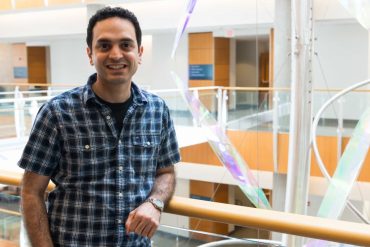
July 24, 2013
Bond LSC post doc recognized for his research on novel HIV drug
Lefteris Michailidis received the 2013 Distinguished Dissertation Award for his work to understand EFdA, a new drug that shows promise to treat resistant HIV viruses with fewer side effects. A four-letter drug could be the next generation of AIDS treatment. EFdA, a new anti-viral drug in development, promises HIV treatment that is more effective with fewer side effects and less resistance. Lefteris Michailidis received the 2013 Distinguished Dissertation Award earlier this year from the MU’s Graduate Faculty Senate for his work to understand how EFdA works on a molecular level. Michailidis currently works as a post-doc…
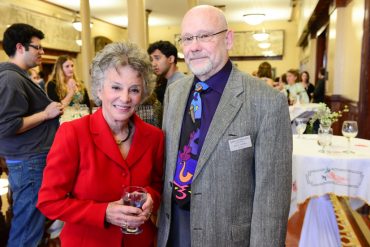
March 15, 2013
Claiming Kin, MU’s 9th annual Life Sciences and Society Symposium kicks off today
Stephanie Coontz, award-winning writer on the history of marriage, chatted with Jack Schultz, director of the Bond Life Sciences Center. Coontz presented the keynote address Friday night at Claiming Kin, MU’s 9th annual Life Sciences and Society Symposium. Check out Saturday and Sunday’s speakers on the subject of kinship athttp://lssp.missouri.edu/claimingkin/schedule. Article originally published on Decoding Science.
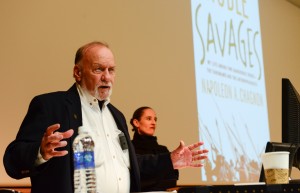
March 13, 2013
Renowned anthropologist speaks about Noble Savages
Napolean Chagnon spoke to a full house Tuesday in Monsanto Auditorium about his new book, Noble Savages. Chagnon joined MU’s Department of Anthropology as Distinguished Research Professor and Chancellor’s Chair of Excellence in 2013. He was elected to the National Academy of Sciences in 2012, but is most known for contributions to his genealogical research, his contributions to evolutionary theory in cultural anthropology and his work in the study of warfare. His new book is a retrospective look at his work as an anthropologist, where he most famously document the Amazonian Yanomamö tribe of Venezuela in the…
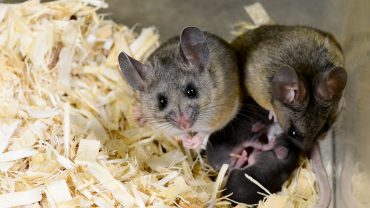
Feb. 12, 2013
It’s a matter of territory
Territory matters to California mice when it comes to mating. Males in this monogamous mouse species use their scent glands to mark the boundaries of their home range, making their dominance known one scent at a time to other males. Too much bisphenol A (BPA) in their environment can change that, short-circuiting their ability to complete this crucial task. Male mice fed BPA couldn’t mark territory when a normal male entered their environment, putting them at a disadvantage. That means the chemical could seriously impact whether these mice pass their genes on to the next generation. Cheryl Rosenfeld, a researcher…